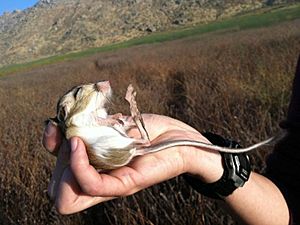Desert kangaroo rat facts for kids
Quick facts for kids Desert kangaroo rat |
|
|---|---|
 |
|
| Conservation status | |
| Scientific classification | |
| Genus: |
Dipodomys
|
| Species: |
deserti
|
The desert kangaroo rat (Dipodomys deserti) is a type of rodent. It belongs to the Heteromyidae family. You can find these rats in the desert areas of southwestern North America. They are one of the larger kangaroo rats. They can grow to be over 12 inches (30 cm) long. They also weigh more than 3.2 ounces (91 grams).
Contents
Where They Live
The desert kangaroo rat lives in dry parts of southwestern North America. This includes places like Death Valley, the Great Basin, the Mojave Desert, and parts of the Sonoran Desert.
While other kangaroo rats can live in different types of soil, desert kangaroo rats prefer loose sand. They often live in sandy dune areas. Some of these places, like Death Valley, are among the hottest deserts in the United States.
Their Home
Desert kangaroo rats live in desert areas with sandy soil. There isn't much plant life there. You might see creosote bushes, different grasses, and cacti.
These rats dig burrow systems under small mounds of soil. These mounds can be 6 to 9 meters wide. They sleep in a special den inside their burrow during the day. They seal off their den when it gets too hot or cold. A group of 6 to 12 burrows, spread out, might form a colony. But usually, these rats live alone.
How They Live
What They Eat
Desert kangaroo rats mainly eat seeds. They tend to pick larger seeds than other similar rodents in the same area. They also seem to choose seeds that have lots of carbohydrates, which give them energy.
Unlike some other kangaroo rats, the desert kangaroo rat does not eat green plants. When they look for food, they move in short bursts. They stop often, usually about 7 meters (22 feet) between stops.
How They Get Water
Most kangaroo rat species live in dry places. They are famous for getting most of their water from their food. This is called metabolic water. Desert kangaroo rats do drink water if it's available. But most of their water comes from the processes inside their bodies. They are very good at living with very little water. They can go for 2 to 3 weeks without needing new water.
Special Body Features
Amazing Kidneys
Kangaroo rats can live with very little water because they have amazing kidneys. Kidneys help remove waste from the body without losing too much water. They do this by making urine very concentrated.
Small rodents are better at saving water than larger animals. The desert kangaroo rat has kidneys that are similar to other rodents. But their kidneys have much longer papilla. These special parts of the kidney help them make very concentrated urine. This means they lose very little water when they go to the bathroom.
Long Noses
The desert kangaroo rat has the longest nasal cavity of all kangaroo rats. This long nose helps them save water. When they breathe out hot, dry air, their long nasal passages cool the air. As the air cools, moisture is released and reabsorbed by their body. This helps them keep precious water inside.
How They Interact
Foot Drumming
Kangaroo rats often drum their feet on the ground. Different types of kangaroo rats have different drumming patterns. Scientists think they developed this behavior on their own. Some kangaroo rats drum to tell others where they are. Other rats might drum back.
But this is not how the desert kangaroo rat uses drumming. These rats live in sand dunes, where food is hard to find. When a desert kangaroo rat hears another rat drumming, it comes out of its burrow. It will then chase the other rat away or even fight it.
Staying Safe from Predators
Desert kangaroo rats face a high risk of being eaten by predators. This is for a few reasons. First, they look for food alone. They don't have other rats to help watch out for snakes or other dangers. Second, food is scarce in the desert and spread out. So, these rats have to spend a lot of time outside their burrows looking for food. Because of these dangers, the desert kangaroo rat has developed ways to protect itself.
Dealing with Snakes
The Merriam's kangaroo rat tries to avoid predators. But the desert kangaroo rat acts more aggressively. If a snake comes near, the desert kangaroo rat drums its feet. It then moves close to the snake and kicks sand into the air. This is very risky for a small rodent! But it does this to let the snake know it has been seen. Snakes are less likely to attack if their prey knows they are there. Desert kangaroo rats kick sand because they live in loose sand dunes. They also use their strong back legs to kick attacking snakes away. This helps them avoid being bitten and injected with venom.


